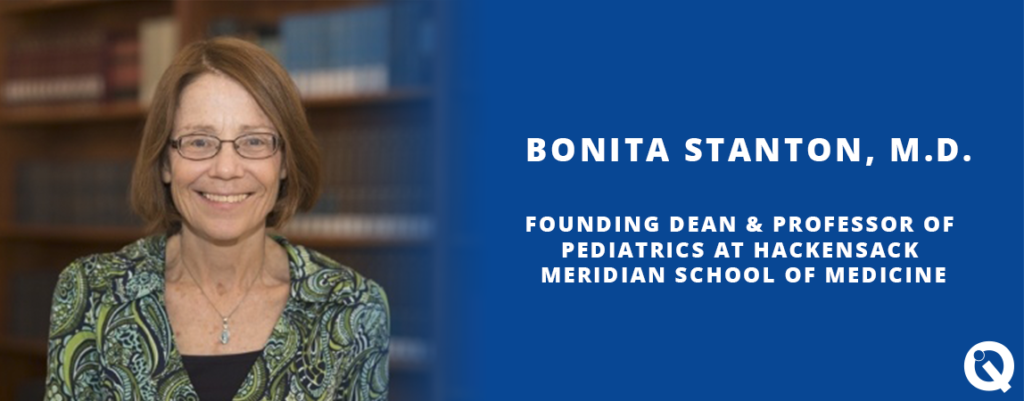Bonita Stanton, M.D., is the Founding Dean and Professor of Pediatrics at Hackensack Meridian School of Medicine, which is a member of the Quality Institute’s Education Council.
What steps is the medical school taking to combat racial bias in health care, and to address racism as a health care issue?
It is a great opportunity to start a new medical school and create a school that is really going to be different. I recruited a small number of individuals who shared my sense of — for lack of any other word really, shame — that the health outcomes in the United States are so unequal, and that this inequality is based on characteristics that should not be driving health. Therefore, the vision that we created for our medical school is actually quite simple. Each person in New Jersey, and eventually in the United States, regardless of race or socioeconomic status, will enjoy the highest levels of wellness in an economically and behaviorally sustainable fashion.
How will the medical school achieve that vision?
We have pillars supporting our future vision. Among these are three that I shall mention here. First, continue to serve and learn from the engagement of underrepresented minority populations among students, faculty, staff, and community. The total number of African American males in medical school is only marginally higher than it was in the late 1970’s; the percentage is actually lower because the total number of medical students has increased. A second, related pillar emphasizes the importance of the idea that community and behavior drive well-being. We want all of our students to understand that the communities from which their patients come will be more impactful to their patients’ long-term outcomes than anything that we can do directly for them.
A second pillar is to embrace and model our professional roots of empathy toward suffering, excellence in medical care, and humility in service. A third pillar is the integration of life-long learning and inquiry into physician practice, and the importance of working in communion with scholars and practitioners of other disciplines to integrate their perspectives, experiences and tools.
How has the COVID-19 pandemic caused you to rethink your curriculum to better prepare students?
There were many ways in which COVID-19 has changed the way we practice. While the duration of these practice changes is unknown at this point, it is clear that at least some of them will impact health outcomes. As examples, telemedicine came into its own. For well over a decade, we have been waiting for that to happen — and trying to participate —and suddenly over a period of less than three months telemedicine has flourished and has been well received by practitioners, health care systems and patients. However, it is not being delivered with the same effectiveness in our minority and our underrepresented communities. So in something that many of us have been looking forward to as the great equalizer — patients would no longer have to struggle to catch three different buses in order to get to the office on time — we are seeing health disparities. However, we are observing this early in the history of telemedicine so we can change it.
Second, our students are trained in the appropriate use and understanding of personal protective equipment and what is required under specific circumstances. I wish I believed that COVID-19 was going to be the only pathogen of the century. But we have every reason to believe, looking at the encroachment of humans on the natural environment where these pathogens live with animals, and recent history, that it will not be the only serious new pathogen over the next several decades. To the contrary, there has been a sharp uptick in the number of new illnesses caused by animal pathogens just since the turn of the century. And so our students will need to really understand how transmission occurs.
And the third point, as I alluded to earlier, our students are seeing very clearly how COVID-19 is yet another example of a pathogen that, for a range of environmental, economic, societal, and biologic reasons, disproportionately impacts underrepresented minorities.
How has your experience as the Maternal Child Health Director for the World Bank influenced your work at the medical school?
In the 1980’s, I headed a research and service program specifically addressing the prevention and treatment of diarrheal diseases in urban slums in Bangladesh. When the World Bank learned about our work, they asked me if I would serve in this role. They were trying a new approach to economic development in severely impoverished nations and began with a major focus on maternal-child health and education. This was also the first time that the World Bank had collaborated in a financial support program with other nations and donors, including USAID. The approach to treat abject poverty in developing nations now includes a health education component. This experience is fundamental to our vision for the School of Medicine and has driven my whole career since that point.
We like to ask people something about themselves outside of work. Can you tell us where we might find you on one of your days off?
In 1958, my father built our family a cottage on a little island in Long Island Sound off the Branford and East Haven Shores of Connecticut. Today, there is still no electricity —although unfortunately now I can connect with my cell phone. There are no vehicles and no roads or sidewalks — only paths and thirteen cottages. The wildlife is magnificent, and the swimming — out to nearby rocky islands or, in our youth, around the island. The days are filled with swimming, kayaking, rowing, bird watching, searching for beach treasures and, for those inclined, fishing or sailing.

